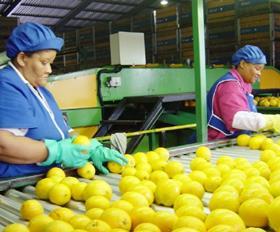
Japan’s grapefruit market has enjoyed a fairly smooth transition in supplies from Florida to South Africa this year, with prices holding up well, according to local market reports.
Shipments from Florida, which totalled 4.8m cartons in 2011/12, finished two weeks earlier than last season in week 13, clearing the way for a strong start to the season for South African arrivals.
The first container loads from South Africa arrived on 23 May, followed by the first charter shipment on 1 June carrying around 4,000 pallets.
Major citrus importer Goldspan, which has completely finished with its Florida grapefruit programme, reported good market conditions for South African arrivals.
“The market is starting the South African season with a low inventory level; the transition has gone smoothly,” confirmed the company’s Toshi Teshima, while cautioning that it was too early to make volume predictions for the season.
“There could be up to 12 charter vessels that come in from South Africa during the season but it’s difficult to tell at this stage due to the crop situation there and the fruit sizing.”
Indeed, South Africa’s grapefruit crop appears to be weighted towards smaller sizes this year, with a shortage of fruit suited to Japan’s market requirements.
“There are a lot of small sizes; the crop appears to be peaking on count 50-55, where the preferred size here is traditionally around count 35-40,” said Teshima. “The internal quality is better than last year though.”
Hisao Takeda of Yamano & Associates, a marketing consultancy that represents the Florida Department of Citrus in Japan, said that warmer weather in Japan during May and June was also helping to drive demand for citrus fruits.
“The wholesale price of lemons is 12 per cent up on the three-year average while grapefruit prices are 6 per cent higher,” he said. “Some of the grapefruit price increase can also be attributed to predictions of reduced shipments from South Africa this year.”
While grapefruit is the big focus for South African citrus exports to Japan, there are also smaller programmes for oranges and clementines, although Teshima noted that Goldspan will be treading cautiously with these products.
“Oranges `from South Africa` are just about to start, but the fruit sizes are smaller and we have to be aware that the market here wants larger sizes, so we’ll be progressing carefully with this because we need to make sure supply matches up with demand,” he said. “Clementines can also be imported but this is risky due the cold treatment protocol.'
The Japanese market is coming to the end of a generally difficult season for California navel orange imports, according to Teshima. “Orange demand could be described as stable but inventory levels are quite high as there’s been an excessive incoming volume,” he noted.
As of the end of May, there were around 1m cartons of oranges in storage in Japan, and up to 40-50 per cent of these were made up of US Tangelos.
Supplies of US mandarins to Japan were crimped by the February freeze in California, and Japanese importers appear to have brought in Tangelos as a type of substitute for W Murcott mandarins this year, but the fruit did not receive the desired reception from consumers, according to some market sources.



